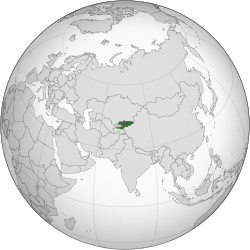
The economy of Kyrgyzstan is highly dependent on agriculture and mining, [1] as both sectors make up more than one-third of Kyrgyzstan's economy. While it was part of the Soviet Union, Kyrgyzstan was one of the major producers of uranium during the 1950s. [2] However, uranium mining activity would cease to exist by the 1990s. [3] In 2022, Kyrgyzstan gained full control of the Kumtor Gold Mine, one of the largest gold deposits in the world, after settling a dispute with Centerra Gold. [4] In 2021, the three major export partners of Kyrgyzstan were the United Kingdom, Kazakhstan, and Russia [5] and in 2019, the three major import partners of Kyrgyzstan were China, Russia, and Kazakhstan. [6]